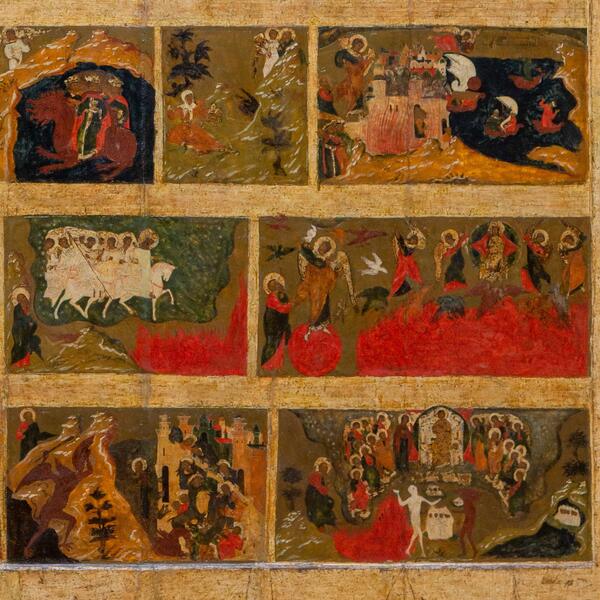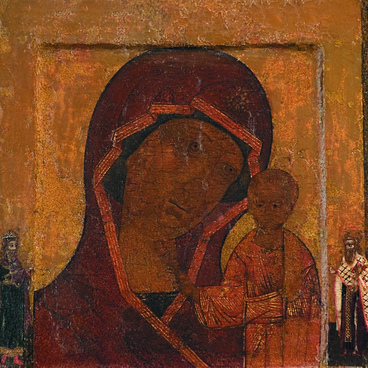The Book of Revelation by John the Apostle is considered to be the Bible book that has inspired the largest number of illustrations, with at least one image based on every paragraph.
Also known as the Apocalypse, this final book of the New Testament was first mentioned in the works of Tertullian, Clement of Alexandria, Irenaeus, and Eusebius (the 2nd century). It was only accepted as a canonical book in the 4th century. The book describes various frightening phenomena and catastrophes which precede the Second Coming of Jesus, including the birth of the Antichrist, and the Last Judgment. The imagery includes the Horsemen of the Apocalypse, the Whore of Babylon, the Woman Clothed with the Sun, and many other allusions borrowed heavily from the Old Testament and has led to a wide variety of interpretations.
The book ends by prophesying the victory of God over Satan, and the New Jerusalem where God will always dwell with the righteous. For the followers of Christ, the words “Even so, come, Lord Jesus!” represented the fervent wish to hasten this victory.
The icon on display illustrates chapters 13 through 20 of the Book of Revelation. This is an example of rare iconography: only two other similar icons of the 16th century are known. The scenes are to be read from left to right and from top to bottom. They show beasts emerging from the sea and the earth, angels pouring out the bowls of wrath, and the triumph of the One who sits on the throne.
The icon demonstrates the typical traits of 16th-century iconography. The gloomy color palette of the icon dominated by the dull green color stands in contrast to the wide horizontal golden stripes between the rows of scenes. Originally, there were red inscriptions against the golden background explaining the depicted scenes, but this text has faded. The color palette contributes to the intensity of the image and fills it with the expressiveness typical of the Yaroslavl icon painting of the turn of the 17th century. The faces, hands, and other uncovered parts of the body are painted with dark ocher on a dense layer of dark brown or dark olive green underpaint. By doing this, the icon painter was able to reproduce the suspenseful and tense atmosphere and the expressiveness of the depicted figures.
The icon was restored at the Igor Grabar Art Conservation Center in Moscow in 2012.
Also known as the Apocalypse, this final book of the New Testament was first mentioned in the works of Tertullian, Clement of Alexandria, Irenaeus, and Eusebius (the 2nd century). It was only accepted as a canonical book in the 4th century. The book describes various frightening phenomena and catastrophes which precede the Second Coming of Jesus, including the birth of the Antichrist, and the Last Judgment. The imagery includes the Horsemen of the Apocalypse, the Whore of Babylon, the Woman Clothed with the Sun, and many other allusions borrowed heavily from the Old Testament and has led to a wide variety of interpretations.
The book ends by prophesying the victory of God over Satan, and the New Jerusalem where God will always dwell with the righteous. For the followers of Christ, the words “Even so, come, Lord Jesus!” represented the fervent wish to hasten this victory.
The icon on display illustrates chapters 13 through 20 of the Book of Revelation. This is an example of rare iconography: only two other similar icons of the 16th century are known. The scenes are to be read from left to right and from top to bottom. They show beasts emerging from the sea and the earth, angels pouring out the bowls of wrath, and the triumph of the One who sits on the throne.
The icon demonstrates the typical traits of 16th-century iconography. The gloomy color palette of the icon dominated by the dull green color stands in contrast to the wide horizontal golden stripes between the rows of scenes. Originally, there were red inscriptions against the golden background explaining the depicted scenes, but this text has faded. The color palette contributes to the intensity of the image and fills it with the expressiveness typical of the Yaroslavl icon painting of the turn of the 17th century. The faces, hands, and other uncovered parts of the body are painted with dark ocher on a dense layer of dark brown or dark olive green underpaint. By doing this, the icon painter was able to reproduce the suspenseful and tense atmosphere and the expressiveness of the depicted figures.
The icon was restored at the Igor Grabar Art Conservation Center in Moscow in 2012.



